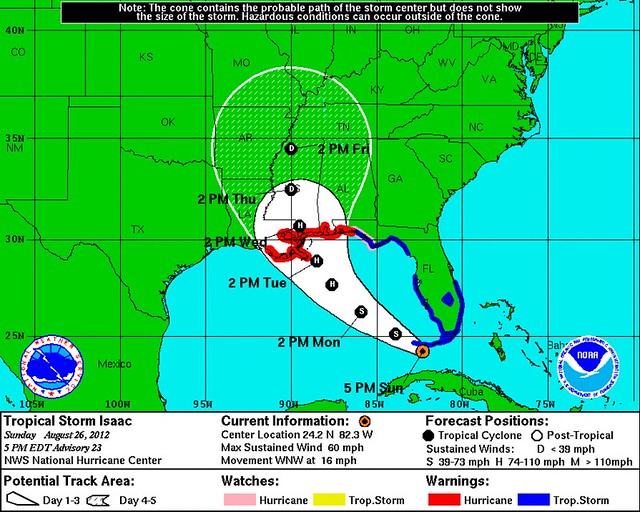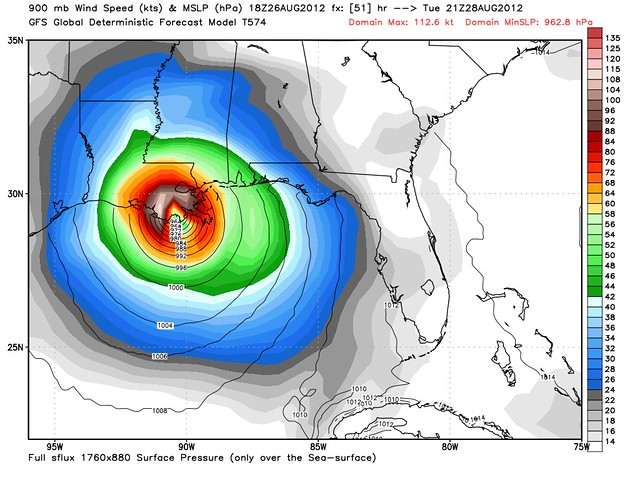[NOTE: check the blog homepage and follow me on Twitter for the very latest.]
* * * * *
In a bizarrely low-key press conference that seemed more focused on calming residents’ “anxiety” and vaguely telling them to “be prepared” (and then making of a series of mundane announcements about municipal matters like trash collection and parking restrictions) than on advising them to take specific, concrete steps commensurate to the risk of a possibly major hurricane potentially making a direct hit on America’s most hurricane-vulnerable city starting in about 48 hours, New Orleans Mayor Mitch Landrieu did his best Ray Nagin impression Sunday, announcing a no-evacuation, “shelter in place” plan that suggests a stunning level of confidence that a worst-case scenario won’t happen, at a time when it remains, meteorologically speaking, very much in play.
The possibility that residents would be “sheltering in place” in a “place” the could, in the worst-case scenario, be swallowed up by the Gulf of Mexico, was not mentioned.
Mayor Landrieu said he did not anticipate announcing any revisions to the plan — such as a decision to order evacuations, a possibility he explicitly downplayed — until around noon tomorrow, by which time the onset of bad weather would be around 24 hours away. Despite reams of pre-Katrina literature indicating that it takes 48 to 72 hours to evacuate New Orleans in the event of a major hurricane threatening a direct hit, and despite the experience of 2005’s rushed and incomplete evacuation so flawed that it left 50,000 people to be rescued from rooftops and such by the Coast Guard, Mayor Landrieu apparently thinks 24 hours is enough time to make an evacuation work, if one is needed.
Okay then.
I want to be fair here. I’m neither a meteorologist nor a New Orleans official, planner or expert. Perhaps Landrieu is right, and I’m wrong. Perhaps New Orleans now has plans that will allow it to effectively evacuate in 24 hours’ time. My understanding has been that that’s basically impossible, but again, I’m concededly not an expert. It’s certainly true that, by midday tomorrow, we’ll have more and better information about Isaac’s projected path and intensity at landfall, both of which remain maddeningly difficult to pin down right now. So if it’s reasonably possible to wait until tomorrow morning to make the call, that would certainly be preferable. I’m just not so sure it’s reasonably possible. I thought the decision needed to be made today, despite the admittedly imperfect information and the very significant chance of a false alarm.
Even if an evacuation can reasonably be begun tomorrow if necessary, Mayor Landrieu certainly should have done more to prepare residents now for the possibility. In contrast to Governor Bobby Jindal, who explicitly advised residents of low-lying coastal areas to prepare today for a likely evacuation tomorrow (and even urged them to voluntarily leave tonight), Landrieu was maddeningly vague in telling residents what to “prepare” for. He seemed to be advising them to “prepare” to “shelter in place” — in other words, to stock up on essentials, etc. — than to prepare for possible evacuations. Moreover, the city government’s relatively nonchalant attitude at present guarantees that most private employers will take a similar attitude, meaning lots of residents with jobs won’t feel free to take off work tomorrow to evacuate.
All in all, I’d describe it as an epic municipal clusterf*** rivaling the run-up to Katrina in 2005. But again, maybe I’m wrong. Maybe someone can tell me why that’s so. For the moment, I’m very concerned that the New Orleans government is again revealing itself to be completely incompetent and not up to the task — and is making itself dependent on the vagaries of atmospheric fate. In other words, Landrieu had better hope he’s lucky, and the storm goes elsewhere (which it may), or doesn’t get as strong as it clearly could (but might not). Landrieu paid lip service to the idea of “preparing for the worst” — but, categorically, he is not advising his residents to do that. He’s advising them to prepare for a mid-range scenario, not the best case but certainly not the realistic worst case.
As a reminder of that worst case, here’s a quartet of computer model maps, showing the forecasts by four of the most reliable models. Both the GFS (top right) and the HWRF (bottom left) would be very bad for New Orleans.
I want to emphasize two things again. First, I am not predicting a New Orleans landfall, or a major-hurricane landfall, or anything else. I am not “predicting” anything. I am calling attention to, and hopefully providing some context for, various forecasts and scenarios. I acknowledge that Isaac may well hit a location other than New Orleans, and/or may well not strengthen as much as some of the models forecast (or it could strengthen and then weaken at the last minute, like Katrina did). I say all this because I’m acutely aware that, if the worst-case scenario doesn’t happen, the “OMG OVERHYPED!!!” trolls will come out of the woodwork, arguing that the non-occurrence of the worst case somehow proves that “Landrieu was right,” and preparing for the worst was never a good idea. Of course that’s nonsense — no one is saying the New Orleans nightmare will definitely happen. The point is that we don’t know, and can’t know, what will happen at this point, so the only prudent thing to do is to prepare for the realistic worst case. Landrieu himself acknowledged that principle, but then utterly failed to follow through, in my opinion.
The second point I want to emphasize is that I don’t mean to suggest a New Orleans landfall is the only scenario that “matters.” There are plenty of other places that could be adversely affected by Isaac, and folks in those places should all be appropriately preparing too. The reason I focus on New Orleans is that while most other scenarios would be “ordinary” hurricane landfalls — though a Mobile Bay hit would be a pretty epic flood in its own right — a direct hit on New Orleans, particularly if preceded by no evacuation or an inadequate evacuation, could be uniquely devastating, indeed potentially far worse than Katrina (which was not that strong in New Orleans; it only became a calamity because of Army Corps of Engineers failures). Please don’t quote that as a prediction that “Isaac will be worse than Katrina!!!1!”; I’m just saying the possibility exists for a worst-case storm, someday, to be substantially worse, which is why a New Orleans threat will always swamp other scenarios in terms of newsworthiness. But if the New Orleans threat eventually diminishes and the focus rightly turns to the storm’s ultimate target, I will certainly say more about that place, wherever it is. In the mean time, everyone in a watch or warning zone on the map above should prepare appropriately.
P.S. Hot off the presses as I publish this, the new, 18Z GFS model:
No relief from the GFS. Still a disaster scenario for the Big Easy. In fact, that track is slightly closer to New Orleans than the previous one, arresting, at least for now, a somewhat hopeful westward trend that seemed like it might take Issac toward the less populated Texas-Louisiana border area.












Join the conversation as a VIP Member